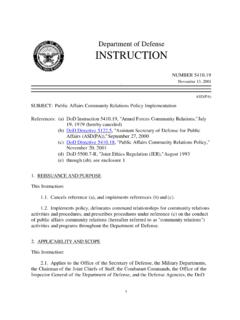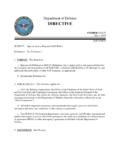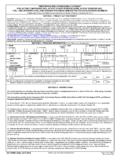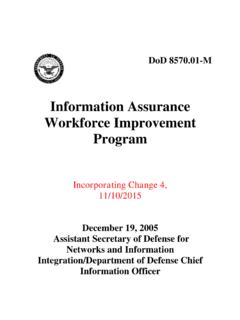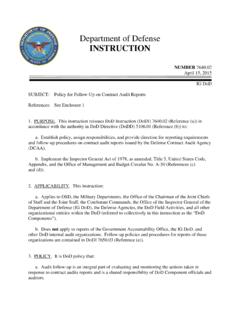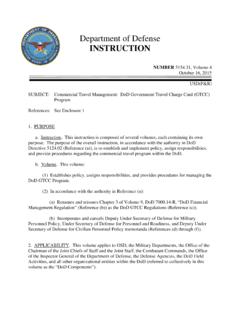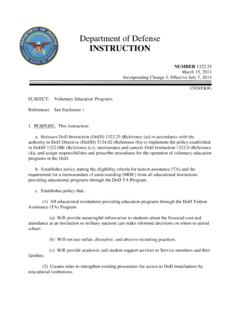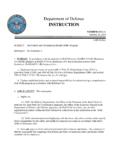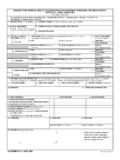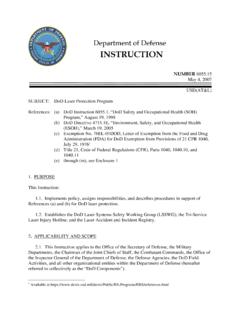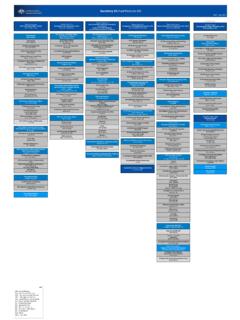Transcription of DoDD 5205.02E, June 20, 2012, Incorporating Change 1 on ...
1 Department of Defense DIRECTIVE NUMBER June 20, 2012 Incorporating Change 1, Effective May 11, 2018 USD(I) SUBJECT: DoD operations Security (OPSEC) Program References: See Enclosure 1 1. PURPOSE. This Directive: a. Reissues DoD Directive (DoDD) (Reference (a)) to update established policy and assigned responsibilities governing the DoD OPSEC program, and incorporate the requirements of National Security Decision Directive Number 298 (Reference (b)) that apply to the DoD. b. Pursuant to Reference (b), establishes the Director, National Security Agency (DIRNSA) as the Federal Executive Agent (EA) for interagency OPSEC training and assigns responsibility for maintaining an Interagency OPSEC Support Staff (IOSS).
2 2. APPLICABILITY. This Directive applies to the OSD, the Military Departments, the Office of the Chairman of the Joint Chiefs of Staff (CJCS) and the Joint Staff, the Combatant Commands, the Office of the Inspector General of the Department of Defense, the Defense Agencies, the DoD Field Activities, and all other organizational entities within the DoD (hereinafter referred to collectively as the DoD Components ). 3. DEFINITIONS. See Glossary. 4. POLICY. It is DoD policy that all DoD missions, functions, programs, and activities shall be protected by an OPSEC program that implements DoD Manual (Reference (c)). a. OPSEC shall be considered across the entire spectrum of DoD missions, functions, programs, and activities.
3 The level of OPSEC to apply is dependent on the threat, vulnerability, and risk to the assigned mission, function, program, or activity, and available resources. DoDD , June 20, 2012 Change 1, 05/11/2018 2 b. OPSEC and other security and information operations programs shall be closely coordinated to account for force protection and the security of information and activities. c. DoD personnel shall maintain essential secrecy of information that is useful to adversaries and potential adversaries to plan, prepare, and conduct military and other operations against the United States and shall safeguard such information from unauthorized access and disclosure in accordance with DoD Manual (Reference (d)).
4 D. The OPSEC process shall be used to identify and mitigate indicators of intentions, capabilities, operations , and activities. e. OPSEC countermeasures shall be employed to deny to adversaries and potential adversaries indicators that reveal critical information about DoD missions and functions. 5. RESPONSIBILITIES. See Enclosure 2. 6. INFORMATION COLLECTION REQUIREMENTS. The reporting requirements in this Directive have been assigned Report Control Symbol DD-INTEL(A)2228 in accordance with DoD Volume 1 of DoD Manual (Reference (e)). 7. RELEASABILITY. UNLIMITED. This Directive is approved for public release and is available on the Internet from the DoD issuances website at Cleared for public release.
5 This directive is available on the Directives Division Website at 8. EFFECTIVE DATE: This Directive is effective June 20, 2012. a. This Directive is effective June 20, 2012. b. This Directive must be reissued, cancelled, or certified current within 5 years of its publication in accordance with DoD Instruction (Reference (f)). If not, this Directive will expire effective June 20, 2022 and be removed from the DoD Issuances Website. Ashton B. Carter Deputy Secretary of Defense Enclosures 1. References 2. Responsibilities GlossaryDoDD , June 20, 2012 Change 1, 05/11/2018 ENCLOSURE 1 3 ENCLOSURE 1 REFERENCES (a) DoD Directive , DoD operations Security (OPSEC) Program, March 6, 2006 (hereby cancelled) (b) National Security Decision Directive Number 298, National operations Security Program, January 22, 1988 (c) DoD , DoD operations Security (OPSEC) Program Manual, November 3, 2008 (d) DoD Manual , DoD Information Security Program, February 24, 2012 dates vary by volume (e) DoD , Department of Defense Procedures for Management of Information Requirements, June 30, 1998 (e)
6 DoD Manual , Volume 1, DoD Information Collections Manual: Procedures for DoD Internal Information Collections, June 30, 2014, as amended (f) DoD Instruction , DoD Directives Program, October 28, 2007 (gf) Deputy Secretary of Defense Memorandum, Reserve Component Joint Web Risk Assessment Cell, February 12, 1999 (hg) DoD , National Industrial Security Program Operating Manual (NISPOM), February 28, 2006, as amended (ih) Secretary of Defense Memorandum, Strategic Communication and Information operations in the DoD, January 25, 2011 (j) DoD Instruction , Critical Program Information (CPI) Protection Within the Department of Defense, July 16, 2008 (k)
7 Joint Publication 1-02, Department of Defense Dictionary of Military and Associated Terms, current edition (i) DoD Instruction , Critical Program Information (CPI) Identification and Protection Within Research, Development, Test, and Evaluation (RDT&E), May 28, 2015, as amended (j) Office of the Chairman of the Joint Chiefs of Staff, DoD Dictionary of Military and Associated Terms, current edition (lk) Chairman of the Joint Chiefs of Staff Instruction , Joint operations Security, July 17, 2008 DoDD , June 20, 2012 Change 1, 05/11/2018 ENCLOSURE 2 4 ENCLOSURE 2 RESPONSIBILITIES 1. UNDER SECRETARY OF DEFENSE FOR INTELLIGENCE (USD(I)).
8 The USD(I), in addition to the responsibilities in section 11 of this enclosure, shall: a. Establish and oversee the implementation of policies and procedures for the conduct of DoD OPSEC. b. Report annually to the Secretary of Defense on the status of the DoD OPSEC Program. c. Coordinate and synchronize OPSEC matters and policies affecting more than one DoD Component and other Federal agencies. e. Develop guidance for conducting OPSEC assessments and surveys. f. In coordination with the Under Secretary of Defense for Acquisition, Technology, and Logistics (USD(AT&L)), develop standards and procedures for the evaluation and protection, when necessary, of unclassified and classified contract efforts.
9 G. Assign DoD representatives to the IOSS. h. In coordination with the Under Secretary of Defense for Policy (USD(P)), the Under Secretary of Defense for Personnel and Readiness (USD(P&R)), and the CJCS, oversee the establishment and maintenance of a professionally trained and educated OPSEC workforce as part of information operations (IO) force development. i. In accordance with Deputy Secretary of Defense Memorandum (Reference (gf)), develop procedures and guidelines to be implemented by the DoD Components for OPSEC reviews of DoD information shared via Internet-based capabilities. j. Establish a training consortium comprised of subject matter experts from the OPSEC community to identify training requirements; review and update OPSEC curriculum; and recommend solutions to recognized training issues.
10 2. DIRNSA. The DIRNSA, under the authority, direction, and control of the USD(I), in addition to the tasks in Reference (b) and responsibilities in section 11 of this enclosure shall act as the Federal Executive Agent for interagency OPSEC training, maintain an IOSS to assist executive departments and agencies, as needed, in establishing OPSEC programs, conducting OPSEC surveys, providing OPSEC services, and developing and providing interagency OPSEC training and awareness courses and products. DoDD , June 20, 2012 Change 1, 05/11/2018 ENCLOSURE 2 5 3. DIRECTOR, DEFENSE INTELLIGENCE AGENCY (DIA). The Director, DIA, under the authority, direction, and control of the USD(I), in addition to the responsibilities in section 11 of this enclosure, shall provide intelligence and counterintelligence threat analysis to support OPSEC planning to all DoD Components.
